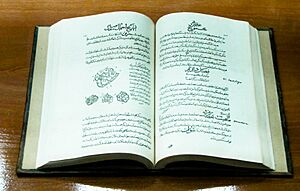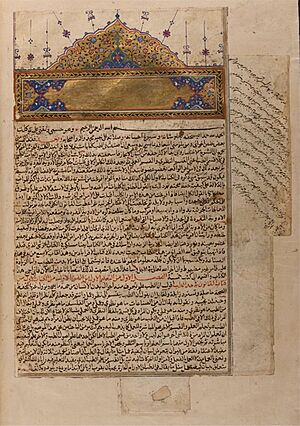The Canon of Medicine facts for kids

Persian version of The Canon of Medicine at Avicenna's mausoleum in Hamedan
|
|
| Author | Avicenna |
|---|---|
| Original title | القانون في الطب |
| Language | Arabic |
| Genre | Medical literature |
| Published | 1025 (Arabic) |
The Canon of Medicine (Arabic: القانون في الطب, romanized: al-Qānūn fī l-ṭibb; Persian: قانون در طب, romanized: Qānun dar Teb; Latin: Canon Medicinae) is an encyclopedia of medicine in five books compiled by Muslim Persian physician-philosopher Avicenna (ابن سینا, ibn Sina) and completed in 1025. It is among the most influential works of its time. It presents an overview of the contemporary medical knowledge of the Islamic world, which had been influenced by earlier traditions including Greco-Roman medicine (particularly Galen), Persian medicine, Chinese medicine and Indian medicine. Its translation from Arabic to Latin in 12th century Toledo greatly influenced the development of medieval medicine. It became the standard textbook for teaching in European universities into the early modern period.
The Canon of Medicine remained a medical authority for centuries. It set the standards for medicine in Medieval Europe and the Islamic world and was used as a standard medical textbook through the 18th century in Europe. It is an important text in Unani medicine, a form of traditional medicine practiced in India.
Contents
Title
The English title Canon of Medicine is derived from the common medieval Latin Canon Medicinae, itself a translation of the original Arabic القانون في الطب (al-Qānūn fī aṭ-Ṭibb), with the same meaning. "Canon" (often translated in English as "law" or "legal code") here connotes an ordered system, or complete, universal encyclopedia. The common medieval version of the title was Liber Canonis.
Development
The medical traditions of Galen, and thereby Hippocrates, had dominated Islamic medicine from its beginnings. Avicenna sought to fit these traditions into Aristotle's natural philosophy. He began writing the Canon in Gorganj, continued in Rey and completed it in Hamadan in 1025. The result was a "clear and ordered "summa" of all the medical knowledge of Ibn Sīnā's time". It served as a more concise reference in contrast to Galen's twenty volumes of medical corpus.
Overview
The Canon of Medicine is divided into five books:
- Essays on basic medical and physiological principles, anatomy, regimen and general therapeutic procedures.
- List of medical substances, arranged alphabetically, following an essay on their general properties.
- Diagnosis and treatment of diseases specific to one part of the body
- Diagnosis and treatment of conditions covering multiple body parts or the entire body.
- Formulary of compound remedies.
Books 1, 3, and 4 are each further divided into parts (fanns), chapters (ta’līms), subchapters (jumlahs), sections (faṣls), and subsections (bābs).
See also
- Al-Tasrif
- Medical literature
- The Book of Healing
- Al-Nijat


